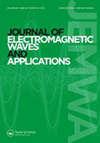Miniaturized quad-band bandpass filter using quad-mode stepped impedance resonator
IF 1.1
4区 工程技术
Q4 ENGINEERING, ELECTRICAL & ELECTRONIC
Journal of Electromagnetic Waves and Applications
Pub Date : 2023-09-16
DOI:10.1080/09205071.2023.2251956
引用次数: 0
Abstract
ABSTRACTA miniaturized quad-band bandpass filter (BPF) using compact quad-mode stepped impedance resonator (IQMSIR) is proposed. Based on the symmetric presented by the resonator, four modes are deduced using even-and odd-mode technique. Design formulas are also derived and they are used to guide the filter design. Multiple coupling circuit technique is employed to realize the four passbands. Independent design for four passbands are achieved due to the physical dimensions and additional cross slots. Upper stopband is performed by adding open loop SIR at I/O ports. Transmission zeros among each passbands are generated, resulting in high isolation and selectivity. A quad-band filter is designed, fabricated and measured. The operating central frequencies of the fabricated filter are at 2.54/3.36/5.24/6.6 GHz. The measured 3-dB fractional bandwidths of the four passbands are about 3.9/6.4/4/4.6% and the minimum insertion losses are about 2.3/0.89/3.2/2.3 dB. Measurements correlate well with the simulation results.KEYWORDS: Miniaturized bandpass filterquad-bandquad-mode stepped impedance resonatorcross couplingtransmission zero (TZ) Disclosure statementNo potential conflict of interest was reported by the author(s).Additional informationFundingThis work was supported in part by the National Natural Science Foundation of China [Grant Number 62171097] and by the National Defense Basic Scientific Research program of China [Grant Number JCKYS2021DC07].Notes on contributorsShichao JinShichao Jin received the B.S. degree in physics from Lanzhou University, Lanzhou, China, in 2004, and the Ph.D. degree in physics from Tsinghua University, Beijing, China, in 2009. He was a senior RF&SatCom engineer from 2009 to 2017 and a professor from 2017 to 2020 with the Beijing Institute of satellite Information Engineering, Beijing, China. He is currently with State Key Laboratory of Space-Ground Integrated Information Technology. He has 13 years' experience in communication systems, microwave circuits, active phased array antenna. His current research interests include satellite communication systems, synthetic aperture radar, RF/analog and millimeter-wave integrated circuits and systems.Kaijun SongKaijun Song (M'09-SM'12) received the M.S. degree in radio physics and the Ph.D. degree in electromagnetic field and microwave technology from the University of Electronic Science and Technology of China (UESTC), Chengdu, China, in 2005 and 2007, respectively. Since 2007, he has been with the EHF Key Laboratory of Science, School of Electronic Engineering, UESTC, where he was a Full Professor. From 2007 to 2008, he was a Postdoctoral Research Fellow with the Montana Tech, University of Mon[1]tana, Butte, MT, USA, working on microwave/millimeter-wave circuits and microwave remote sensing technologies. From 2008 to 2010, he was a Research Fellow with the State Key Laboratory of Millimeter Waves of China, Department of Electronic Engineering, City University of Hong Kong, on microwave/millimeter-wave power-combining technology and Ultra-Wideband (UWB) circuits. Since 2018, he has also been a Full Professor with the School of Electronic Science and Engineering, UESTC.Xueyuan DingXueyuan Ding began his studies at UST in 2017, received his undergraduate degree in 2021. Currently, he is pursuing a master's degree at the University of Electronic Science and Technology.采用四模阶跃阻抗谐振器的小型化四带带通滤波器
提出了一种基于四模阶跃阻抗谐振器(IQMSIR)的小型化四带带通滤波器。基于谐振腔的对称性,利用奇偶模技术推导出了四种模态。并推导了设计公式,用于指导滤波器的设计。采用多重耦合电路技术实现四个通带。由于物理尺寸和额外的交叉槽,实现了四个通带的独立设计。上阻带是通过在I/O端口添加开环SIR实现的。在每个通带之间产生传输零,从而产生高隔离性和选择性。设计、制作并测量了一个四频带滤波器。所制滤波器的工作中心频率为2.54/3.36/5.24/6.6 GHz。测量到的4个通带的3 dB分数带宽约为3.9/6.4/4/4.6%,最小插入损耗约为2.3/0.89/3.2/2.3 dB。测量结果与模拟结果吻合良好。关键词:小型化带通滤波器、带四模阶跃阻抗谐振器、交叉耦合零传输(TZ)披露声明作者未报告潜在的利益冲突。本研究得到国家自然科学基金项目[资助号:62171097]和国防基础科学研究计划项目[资助号:JCKYS2021DC07]的部分资助。作者简介:金世超,2004年获兰州大学物理学学士学位,2009年获清华大学物理学博士学位。2009年至2017年,他是北京卫星信息工程研究所的高级RF&SatCom工程师,并于2017年至2020年担任教授。他目前就职于空间-地面综合信息技术国家重点实验室。他在通信系统,微波电路,有源相控阵天线方面有13年的经验。他目前的研究兴趣包括卫星通信系统,合成孔径雷达,射频/模拟和毫米波集成电路和系统。宋开军(M'09-SM'12), 2005年毕业于中国电子科技大学,获射电物理学硕士学位,2007年获中国电子科技大学电磁场与微波技术专业博士学位。2007年加入电子科技大学电子工程学院EHF科学重点实验室任正教授。2007年至2008年,在美国蒙大拿州蒙大拿州理工学院(University of Montana Tech)从事博士后研究[1],主要从事微波/毫米波电路和微波遥感技术研究。2008年至2010年,他是香港城市大学电子工程系毫米波国家重点实验室研究员,研究方向为微波/毫米波功率组合技术和超宽带电路。2018年起任电子科技大学电子科学与工程学院正教授。丁学元,2017年进入科大学习,2021年获得本科学位。目前,他正在电子科技大学攻读硕士学位。
本文章由计算机程序翻译,如有差异,请以英文原文为准。
求助全文
约1分钟内获得全文
求助全文
来源期刊
CiteScore
3.60
自引率
7.70%
发文量
116
审稿时长
3.3 months
期刊介绍:
Journal of Electromagnetic Waves and Applications covers all aspects of electromagnetic wave theory and its applications. It publishes original papers and review articles on new theories, methodologies, and computational techniques, as well as interpretations of both theoretical and experimental results.
The scope of this Journal remains broad and includes the following topics:
wave propagation theory
propagation in random media
waves in composites and amorphous materials
optical and millimeter wave techniques
fiber/waveguide optics
optical sensing
sub-micron structures
nano-optics and sub-wavelength effects
photonics and plasmonics
atmospherics and ionospheric effects on wave propagation
geophysical subsurface probing
remote sensing
inverse scattering
antenna theory and applications
fields and network theory
transients
radar measurements and applications
active experiments using space vehicles
electromagnetic compatibility and interferometry
medical applications and biological effects
ferrite devices
high power devices and systems
numerical methods
The aim of this Journal is to report recent advancements and modern developments in the electromagnetic science and new exciting applications covering the aforementioned fields.

 求助内容:
求助内容: 应助结果提醒方式:
应助结果提醒方式:


